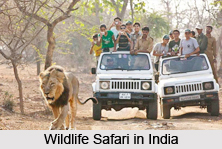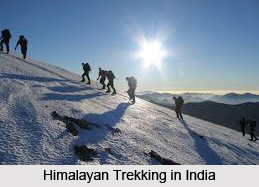 Nature Tourism in India deals with the wildlife sanctuaries, eco tourism sites like waterfalls, lakes, islands, rivers and also the trek to the desert oriented Rajasthan to the snow capped peaks of Himalayas in Uttarakhand.
Nature Tourism in India deals with the wildlife sanctuaries, eco tourism sites like waterfalls, lakes, islands, rivers and also the trek to the desert oriented Rajasthan to the snow capped peaks of Himalayas in Uttarakhand.
Wildlife Safari in India
India is the home of many wildlife sanctuaries with diverse species of birds, mammals and other animals. In India there are around 551 wildlife sanctuaries. Among these wildlife sanctuaries, Project Tiger in India governs 28 Tiger Reserves and they hold special significance in the preservation of Royal Bengal Tiger and White Tigers. Bird Sanctuaries like Keoladeo Ghana National Park attained the status of National Park and also provides the tourists with bird watching activities through binoculars. Several National Parks of the country were formerly wildlife sanctuaries. Some of the most preferred wildlife sanctuaries in India are Borail Wildlife Sanctuary, Van Vihar National Park, Chandaka Elephant Reserve, Thol Wildlife Sanctuary, Satpura National Park, Lakhari Valley Sanctuary, Pakhal Wildlife Sanctuary, Bhimeshwari National Park, Phen Wildlife Sanctuary, Dudhwa National Park, Jawahar Deer Park, Mayani Bird Sanctuary, Overa Wildlife Sanctuary, Belghar Sanctuary, Kadalundi Bird Sanctuary, Okhla Bird Sanctuary, Pin Valley National Park, Gumti Wildlife Sanctuary, Magadi Bird Sanctuary, Bonal Bird Sanctuary, Vansda National Park, Bor Wildlife Sanctuary, Ambapani Sanctuary, Borail Wildlife Sanctuary, Dubare Elephant Camp, Alisagar Deer Park, Fakim Wildlife Sanctuary, Chandraprabha Sanctuary , Attiveri Bird Sanctuary, Pania Wildlife Sanctuary, Nambor Wildlife Sanctuary, Kuno Wildlife Sanctuary and many other wildlife sanctuaries, bird sanctuaries, reptile sanctuaries scattered in the Indian states like West Bengal, Maharashtra, Gujarat, Madhya Pradesh, Kerala, Karnataka, Tamil Nadu, Odisha, Bihar, Jharkhand, Telangana, Andhra Pradesh and many other states of hilly areas like Darjeeling, Sikkim, Jammu and Kashmir and Assam.
Eco Tourism in India
Eco Tourism in India is now booming industry and it is associated with the tourism industry of India. The Government of India and the different state governments in India are now engaged in utilizing the wetlands and the lakes area decorating with the nature. Thus it forms the eco tourism sectors especially located very close to the metropolitan cities like Mumbai, Kolkata, Delhi and Bengaluru. Eco parks in India are actually a protected area that uses ecological landscape features for reducing watering and maintenance, while enhancing wildlife and human values. Being a huge country and rich in natural resources, India is home to numerous eco parks that spread across all parts of the country. The states house the highest numbers of eco parks in India, where one can get the abundant of natural belongings. Some of the eco parks in India are Adyar Eco Park, Courtallam Eco Park, Bandhavgarh Tiger Reserve, Kanha Tiger Reserve, Pench National Park, Rajaji National Park, Gir National Park, New Town Eco Park and many more.
Rural Tourism in India
 India is a land of 7 billion villages and 330 million gods and goddesses. Rural tourism initiatives in India are connecting the present to the past, the avenues to the gallis, and people to people, making history, culture, craft and tradition relevant in a contemporary context. Rural tourism gives the scope not just giving city-slickers a taste of life on the other side of the farm hedge; while they are creating sustainable eco-systems, which provide alternate sources of income for village dwellers without straining their existing resources. Some of the well known villages of India are Goraul, Baragaon, Shirgaon, Champadanga, Telhara, Mayong, Jhargram, Salboni, Sonajhuri, Bolpur, Takdah, Galudi, Ghatshila, Madipally , Suraram, Thorrur and many more villages are supplying best atmosphere to the tourists while they are having a village walks.
India is a land of 7 billion villages and 330 million gods and goddesses. Rural tourism initiatives in India are connecting the present to the past, the avenues to the gallis, and people to people, making history, culture, craft and tradition relevant in a contemporary context. Rural tourism gives the scope not just giving city-slickers a taste of life on the other side of the farm hedge; while they are creating sustainable eco-systems, which provide alternate sources of income for village dwellers without straining their existing resources. Some of the well known villages of India are Goraul, Baragaon, Shirgaon, Champadanga, Telhara, Mayong, Jhargram, Salboni, Sonajhuri, Bolpur, Takdah, Galudi, Ghatshila, Madipally , Suraram, Thorrur and many more villages are supplying best atmosphere to the tourists while they are having a village walks.
Protected Area Permit in India
The Foreigners (Protected Areas) Order 1958 states that a Protected Area Permit (PAP) is required for non-Indian citizens to visit certain areas of north eastern part of India like Meghalaya, Mizoram, Tripura, Manipur and Arunachal Pradesh. There are certain requirements that have to be fulfilled in order to get this permit. Indian citizens who are not resident in these areas need an Inner Line Permit (ILP) to enter these places. The Inner Line Permit is significantly easier to get. One need to require travelling in groups of at least 2 people with a registered travel agent from India or assigned by the Tourism Department of India. While the citizens of Pakistan, Bangladesh, China and Myanmar can get the PAP only with approval of the Ministry of Home Affairs.
Himalayan Tourism in India
From September to May are the popular season to travel through Himalayan Mountain Range and the Indian states which are located at the foothills of Upper Himalayas, Middle Himalayas and the Lesser Himalayas. Himachal Prdaesh, Uttarkhand, Jammu and Kashmir, Leh District and Ladakh District are offering the pilgrimage tourism and the adventure tourism in India. The adventure tourism includes the difficult and moderate treks, adventure to Himalayan River Valley, exploring Great Himalayan Lakes, passing through the Mountain Passes and at last the exploration of national parks and wildlife sanctuaries.
Desert Tourism in India
Indian has only one state with desert. Rajasthan offers royal tourism and the desert tourism while the state is filled with cool and temperate climate and the colourful festivals. The national and international tourist will see here the culture, lifestyle of Thar Desert and also the difficult treks through Thar Desert in India and the camel safari in Thar Desert region. One can visit the Thar cities in Rajasthan, which are dotted with grand heritage hotels, havelis and palaces. The cities like Jaipur, Jodhpur, Bikaner, Udaipur offers the desert tourism in India.
Waterfalls in India
India also offers the waterfalls as the nature tourism area which are not only dotted in the hilly areas, but also in the Chota Nagpur Plateau and Western Ghats Mountain Range in India. Dudhsagar falls, Jog Falls of Karnataka, Nohsngithiang Falls, Meghalaya, Thoseghar Waterfall of Maharashtra, Athirappilly Falls of Kerala, Courtallam Waterfall of Tamil Nadu, Elephanta Falls of Meghalaya, Talakona Waterfall of Andhra Pradesh, Khandadhar Waterfall of Odisha, Chitrakoot Waterfall, Chhattisgarh, Dhuandhar Waterfall of Madhya Pradesh, Vantawng Falls, Mizoram, Hundru Waterfalls in Jharkhand, Kakolat waterfalls in Bihar, Kempty Falls in Uttaranchal and Chadwick Falls in Himachal Pradesh.
Backwaters in India
Only Kerala bears the name as the backwaters destination in India. Kottayam District is renowned for the paddy fields, rubber plantations and the highlands, popular as being the land of letters too. The town of Kollam on the Ashtamudi Lake acts as a gateway to the backwater tours of India. For the nature lovers the best tours are from Kollam District to Alappuzha District. On the seacoast the other backwater destination is Kasargod District that offers best of spots for relaxation and rejuvenation.
Related Articles
Tourism in India
Tourism In Uttarakhand
Tourism In Manipur
Tourism In Rajasthan
Tourism In Udaipur
Leisure Tourism in Rajasthan
Nature Tourism in West Bengal
Tourism In West Bengal
Tourism in Lakshwadeep Island
Indian Village Life
Farming in Indian Villages
Indian Villages
Backwaters In India
Backwaters in Kerala
Kerala Backwaters Destinations
Island Tourism Festival
Indian Islands
Lakes of India
Waterfalls in Madhya Pradesh
Waterfalls of Chhattisgarh
Indian Wildlife Sanctuaries
Eco Parks in India



















